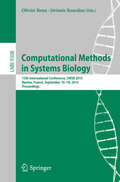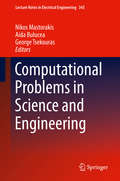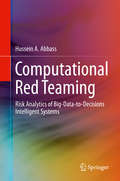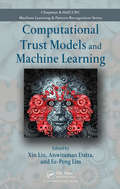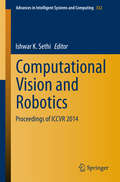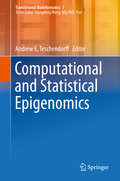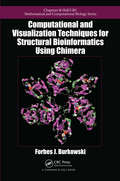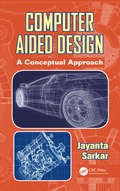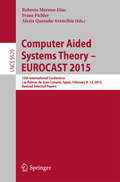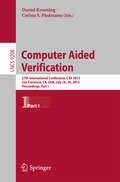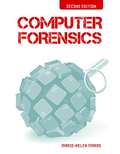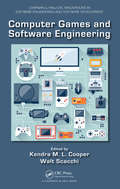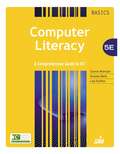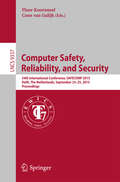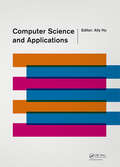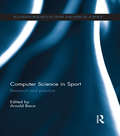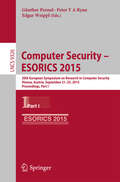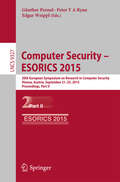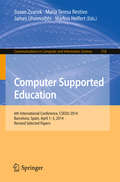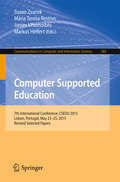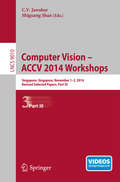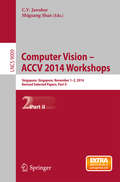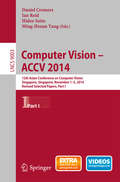- Table View
- List View
Computational Methods in Systems Biology: 13th International Conference, CMSB 2015, Nantes, France, September 16-18, 2015, Proceedings (Lecture Notes in Computer Science #9308)
by Olivier Roux Jérémie BourdonThis book constitutes the refereed proceedings of the 13th International Conference on Computational Methods in Systems Biology, CMSB 2015, held in Nantes, France, in September 2015. The 20 full papers and 2 short papers presented were carefully reviewed and selected from 43 full and 4 short paper submissions. The papers cover a wide range of topics in the analysis of biological systems, networks and data such as model checking, stochastic analysis, hybrid systems, circadian clock, time series data, logic programming, and constraints solving ranging from intercellular to multiscale.
Computational Problems in Science and Engineering (Lecture Notes in Electrical Engineering #343)
by Nikos Mastorakis Aida Bulucea George TsekourasThis book provides readers with modern computational techniques for solving variety of problems from electrical, mechanical, civil and chemical engineering. Mathematical methods are presented in a unified manner, so they can be applied consistently to problems in applied electromagnetics, strength of materials, fluid mechanics, heat and mass transfer, environmental engineering, biomedical engineering, signal processing, automatic control and more.
Computational Red Teaming: Risk Analytics of Big-Data-to-Decisions Intelligent Systems
by Hussein A. AbbassWritten to bridge the information needs of management and computational scientists, this book presents the first comprehensive treatment of Computational Red Teaming (CRT). The author describes an analytics environment that blends human reasoning and computational modeling to design risk-aware and evidence-based smart decision making systems. He presents the Shadow CRT Machine, which shadows the operations of an actual system to think with decision makers, challenge threats, and design remedies. This is the first book to generalize red teaming (RT) outside the military and security domains and it offers coverage of RT principles, practical and ethical guidelines. The author utilizes Gilbert's principles for introducing a science. Simplicity: where the book follows a special style to make it accessible to a wide range of readers. Coherence: where only necessary elements from experimentation, optimization, simulation, data mining, big data, cognitive information processing, and system thinking are blended together systematically to present CRT as the science of Risk Analytics and Challenge Analytics. Utility: where the author draws on a wide range of examples, ranging from job interviews to Cyber operations, before presenting three case studies from air traffic control technologies, human behavior, and complex socio-technical systems involving real-time mining and integration of human brain data in the decision making environment.
Computational Trust Models and Machine Learning (Chapman & Hall/CRC Machine Learning & Pattern Recognition)
by Xin Liu Ee-Peng Lim Anwitaman DattaComputational Trust Models and Machine Learning provides a detailed introduction to the concept of trust and its application in various computer science areas, including multi-agent systems, online social networks, and communication systems. Identifying trust modeling challenges that cannot be addressed by traditional approaches, this book:Explains
Computational Vision and Robotics: Proceedings of ICCVR 2014 (Advances in Intelligent Systems and Computing #332)
by Ishwar K. SethiComputer Vision and Robotic is one of the most challenging areas of 21st century. Its application ranges from Agriculture to Medicine, Household applications to Humanoid, Deep-sea-application to Space application, and Industry applications to Man-less-plant. Today's technologies demand to produce intelligent machine, which are enabling applications in various domains and services. Robotics is one such area which encompasses number of technology in it and its application is widespread. Computational vision or Machine vision is one of the most challenging tools for the robot to make it intelligent. This volume covers chapters from various areas of Computational Vision such as Image and Video Coding and Analysis, Image Watermarking, Noise Reduction and Cancellation, Block Matching and Motion Estimation, Tracking of Deformable Object using Steerable Pyramid Wavelet Transformation, Medical Image Fusion, CT and MRI Image Fusion based on Stationary Wavelet Transform. The book also covers articles from applications of soft computing techniques such as Target Searching and Tracking using Particle Swarm Optimization, PSO-based Functional Artificial Neural Network, etc. The book also covers article from the areas of Robotics such as Solar Power Robot Vehicle, Multi Robot Area Exploration, Intelligent Driving System based on Video Sequencing, Emotion Recognition using MLP Network, Identifying the Unstructured Environment.
Computational and Statistical Epigenomics (Translational Bioinformatics #7)
by Andrew E. TeschendorffThis book introduces the reader to modern computational and statistical tools for translational epigenomics research. Over the last decade, epigenomics has emerged as a key area of molecular biology, epidemiology and genome medicine. Epigenomics not only offers us a deeper understanding of fundamental cellular biology, but also provides us with the basis for an improved understanding and management of complex diseases. From novel biomarkers for risk prediction, early detection, diagnosis and prognosis of common diseases, to novel therapeutic strategies, epigenomics is set to play a key role in the personalized medicine of the future. In this book we introduce the reader to some of the most important computational and statistical methods for analyzing epigenomic data, with a special focus on DNA methylation. Topics include normalization, correction for cellular heterogeneity, batch effects, clustering, supervised analysis and integrative methods for systems epigenomics. This book will be of interest to students and researchers in bioinformatics, biostatistics, biologists and clinicians alike. Dr. Andrew E. Teschendorff is Head of the Computational Systems Genomics Lab at the CAS-MPG Partner Institute for Computational Biology, Shanghai, China, as well as an Honorary Research Fellow at the UCL Cancer Institute, University College London, UK.
Computational and Visualization Techniques for Structural Bioinformatics Using Chimera (Chapman & Hall/CRC Computational Biology Series)
by Forbes J. BurkowskiA Step-by-Step Guide to Describing Biomolecular StructureComputational and Visualization Techniques for Structural Bioinformatics Using Chimera shows how to perform computations with Python scripts in the Chimera environment. It focuses on the three core areas needed to study structural bioinformatics: biochemistry, mathematics, and computation.Und
Computer Aided Design: A Conceptual Approach
by Jayanta SarkarOptimize Designs in Less TimeAn essential element of equipment and system design, computer aided design (CAD) is commonly used to simulate potential engineering problems in order to help gauge the magnitude of their effects. Useful for producing 3D models or drawings with the selection of predefined objects, Computer Aided Design: A Conceptual Appr
Computer Aided Systems Theory - EUROCAST 2015: 15th International Conference, Las Palmas de Gran Canaria, Spain, February 8-13, 2015, Revised Selected Papers (Lecture Notes in Computer Science #9520)
by Roberto Moreno-Díaz Franz Pichler Alexis Quesada-ArencibiaThis volume constitutes the papers presented at the 15thInternational Conference on Computer Aided Systems Theory, EUROCAST 2015, heldin February 2015 in Las Palmas de Gran Canaria, Spain. The total of 107 papers presented were carefully reviewedand selected for inclusion in the book. The contributions are organized intopical sections on Systems Theory and Applications; Modelling BiologicalSystems; Intelligent Information Processing; Theory and Applications ofMetaheuristic Algorithms; Computer Methods, Virtual Reality and ImageProcessing for Clinical and Academic Medicine; Signals and Systems inElectronics; Model-Based System Design, Verification, and Simulation; DigitalSignal Processing Methods and Applications; Modelling and Control of Robots;Mobile Platforms, Autonomous and Computing Traffic Systems; Cloud and OtherComputing Systems; and Marine Sensors and Manipulators.
Computer Aided Verification: 27th International Conference, CAV 2015, San Francisco, CA, USA, July 18-24, 2015, Proceedings, Part I (Lecture Notes in Computer Science #9206)
by Daniel Kroening Corina S. PăsăreanuThe two-volume set LNCS 9206 and LNCS 9207 constitutes the refereed proceedings of the 27th International Conference on Computer Aided Verification, CAV 2015, held in San Francisco, CA, USA, in July 2015. The total of 58 full and 11 short papers presented in the proceedings was carefully reviewed and selected from 252 submissions. The papers were organized in topical sections named: model checking and refinements; quantitative reasoning; software analysis; lightning talks; interpolation, IC3/PDR, and Invariants; SMT techniques and applications; HW verification; synthesis; termination; and concurrency.
Computer Forensics: Cybercriminals, Laws, and Evidence
by Marie-Helen MarasAn Updated Edition of the Definitive Computer Forensics Text. Updated to include the most current events and information on cyberterrorism, the second edition of Computer Forensics: Cybercriminals, Laws, and Evidence continues to balance technicality and legal analysis as it enters into the world of cybercrime by exploring what it is, how it is investigated, and the regulatory laws around the collection and use of electronic evidence. Students are introduced to the technology involved in computer forensic investigations and the technical and legal difficulties involved in searching, extracting, maintaining, and storing electronic evidence, while simultaneously looking at the legal implications of such investigations and the rules of legal procedure relevant to electronic evidence. Significant and current computer forensic developments are examined, as well as the implications for a variety of fields including computer science, security, criminology, law, public policy, and administration.
Computer Games and Software Engineering (Chapman & Hall/CRC Innovations in Software Engineering and Software Development Series)
by Kendra M. L. Cooper Walt ScacchiComputer games represent a significant software application domain for innovative research in software engineering techniques and technologies. Game developers, whether focusing on entertainment-market opportunities or game-based applications in non-entertainment domains, thus share a common interest with software engineers and developers on how to
Computer Literacy Basics: A Comprehensive Guide to IC³
by Dolores Wells Connie Morrison Lisa RuffoloBring your computer literacy course back to the BASICS. COMPUTER LITERACY BASICS: A COMPREHENSIVE GUIDE TO IC3 provides an introduction to computer concepts and skills, which maps to the newest Computing Core Certification (IC3) standards. Designed with new learners in mind, this text covers Computing Fundamentals, Key Applications, and Living Online - everything students need to pass the IC3 exam, and finish the course as confident computer users.
Computer Safety, Reliability, and Security: 34th International Conference, SAFECOMP 2015, Delft, The Netherlands, September 23-25, 2015, Proceedings (Lecture Notes in Computer Science #9337)
by Floor Koornneef Coen Van GulijkThis book constitutes the refereed proceedings of the 34th International Conference on Computer Safety, Reliability, and Security, SAFECOMP 2015, held in Delft, The Netherlands, in September 2014. The 32 revised full papers presented together with 3 invited talks were carefully reviewed and selected from 104 submissions. The papers are organized in topical sections on flight systems, automotive embedded systems, automotive software, error detection, medical safety cases, medical systems, architecture and testing, safety cases, security attacks, cyber security and integration, and programming and compiling.
Computer Safety, Reliability, and Security: SAFECOMP 2015 Workshops, ASSURE, DECSoS. ISSE, ReSA4CI, and SASSUR, Delft, The Netherlands, September 22, 2015, Proceedings (Lecture Notes in Computer Science #9338)
by Floor Koornneef Coen Van GulijkThis book constitutes the refereed proceedings of the 34th International Conference on Computer Safety, Reliability, and Security, SAFECOMP 2015, held in Delft, The Netherlands, in September 2014. The 32 revised full papers presented together with 3 invited talks were carefully reviewed and selected from 104 submissions. The papers are organized in topical sections on flight systems, automotive embedded systems, automotive software, error detection, medical safety cases, medical systems, architecture and testing, safety cases, security attacks, cyber security and integration, and programming and compiling.
Computer Science and Applications: Proceedings of the 2014 Asia-Pacific Conference on Computer Science and Applications (CSAC 2014), Shanghai, China, 27-28 December 2014
by Ally HuThe 2014 Asia-Pacific Conference on Computer Science and Applications was held in Shanghai, December 27-28, 2014. These CSAC-2014 proceedings include 105 selected papers, which focus not only on the research of science and technology of computer sciences, but also on the research of applications, aiming at a quick and immediate effect on
Computer Science in Sport: Research and Practice (Routledge Research in Sport and Exercise Science)
by Arnold BacaComputers are a fundamentally important tool in sport science research, sports performance analysis and, increasingly, in coaching and education programmes in sport. This book defines the field of ‘sport informatics’, explaining how computer science can be used to solve sport-related problems, in both research and applied aspects. Beginning with a clear explanation of the functional principles of hardware and software, the book examines the key functional areas in which computer science is employed in sport, including: knowledge discovery and database development data acquisition, including devices for measuring performance data motion tracking and analysis systems modelling and simulation match analysis systems e-learning and multimedia in sports education Bridging the gap between theory and practice, this book is important reading for any student, researcher or practitioner working in sport science, sport performance analysis, research methods in sport, applied computer science or informatics.
Computer Security -- ESORICS 2015: 20th European Symposium on Research in Computer Security, Vienna, Austria, September 21-25, 2015, Proceedings, Part I (Lecture Notes in Computer Science #9326)
by Edgar Weippl Günther Pernul Peter Y A RyanThe two-volume set, LNCS 9326 and LNCS 9327 constitutes the refereed proceedings of the 20th European Symposium on Research in Computer Security, ESORICS 2015, held in Vienna, Austria, in September 2015. The 59 revised full papers presented were carefully reviewed and selected from 298 submissions. The papers address issues such as networks and Web security; system security; crypto application and attacks; risk analysis; privacy; cloud security; protocols and attribute-based encryption; code analysis and side-channels; detection and monitoring; authentication; policies; and applied security.
Computer Security -- ESORICS 2015: 20th European Symposium on Research in Computer Security, Vienna, Austria, September 21-25, 2015, Proceedings, Part II (Lecture Notes in Computer Science #9327)
by Edgar Weippl Günther Pernul Peter Y A RyanThe two-volume set, LNCS 9326 and LNCS 9327 constitutes the refereed proceedings of the 20th European Symposium on Research in Computer Security, ESORICS 2015, held in Vienna, Austria, in September 2015. The 59 revised full papers presented were carefully reviewed and selected from 298 submissions. The papers address issues such as networks and Web security; system security; crypto application and attacks; risk analysis; privacy; cloud security; protocols and attribute-based encryption; code analysis and side-channels; detection and monitoring; authentication; policies; and applied security.
Computer Security: Principles and Practice
by William Stallings Lawrie BrownComputer Security: Principles and Practice, Third Edition, is ideal for courses in Computer/Network Security. It also provides a solid, up-to-date reference or self-study tutorial for system engineers, programmers, system managers, network managers, product marketing personnel, system support specialists. In recent years, the need for education in computer security and related topics has grown dramatically--and is essential for anyone studying Computer Science or Computer Engineering. This is the only text available to provide integrated, comprehensive, up-to-date coverage of the broad range of topics in this subject In addition to an extensive pedagogical program, the book provides unparalleled support for both research and modeling projects, giving students a broader perspective It covers all security topics considered Core in the EEE/ACM Computer Science Curriculum. This textbook can be used to prep for CISSP Certification, and includes in-depth coverage of Computer Security, Technology and Principles, Software Security, Management Issues, Cryptographic Algorithms, Internet Security and more. The Text and Academic Authors Association named Computer Security: Principles and Practice, First Edition, the winner of the Textbook Excellence Award for the best Computer Science textbook of 2008. Teaching and Learning Experience This program presents a better teaching and learning experience--for you and your students. It will help: Easily Integrate Projects in your Course: This book provides an unparalleled degree of support for including both research and modeling projects in your course, giving students a broader perspective Keep Your Course Current with Updated Technical Content: This edition covers the latest trends and developments in computer security. Enhance Learning with Engaging Features: Extensive use of case studies and examples provides real-world context to the text material. Provide Extensive Support Material to Instructors and Students: Student and instructor resources are available to expand on the topics presented in the text.
Computer Supported Education: 6th International Conference, CSEDU 2014, Barcelona, Spain, April 1-3, 2014, Revised Selected Papers (Communications in Computer and Information Science #510)
by Susan Zvacek Markus Helfert Maria Teresa Restivo James UhomoibhiThis book constitutes the refereed proceedings of the 6th International Conference on Computer Supported Education, CSEDU 2014, held in Barcelona, Spain, in April 2014. The 24 revised full papers presented were carefully reviewed and selected from 242 submissions. The papers address topics such as information technologies supporting learning; learning/teaching methodologies and assessment; social context and learning environments; domain applications and case studies; and ubiquitous learning.
Computer Supported Education: 7th International Conference, CSEDU 2015, Lisbon, Portugal, May 23-25, 2015, Revised Selected Papers (Communications in Computer and Information Science #583)
by Susan Zvacek Markus Helfert Maria Teresa Restivo James UhomoibhiThis book constitutes the refereed proceedings of the 6th International Conference on Computer Supported Education, CSEDU 2014, held in Barcelona, Spain, in April 2014. The 24 revised full papers presented were carefully reviewed and selected from 242 submissions. The papers address topics such as information technologies supporting learning; learning/teaching methodologies and assessment; social context and learning environments; domain applications and case studies; and ubiquitous learning.
Computer Vision - ACCV 2014 Workshops, Part III: Singapore, Singapore, November 1-2, 2014, Revised Selected Papers, Part III (Lecture Notes in Computer Science #9010)
by C. V. Jawahar Shiguang ShanThe three-volume set, consisting of LNCS 9008, 9009, and 9010, contains carefully reviewed and selected papers presented at 15 workshops held in conjunction with the 12th Asian Conference on Computer Vision, ACCV 2014, in Singapore, in November 2014. The 153 full papers presented were selected from numerous submissions. LNCS 9008 contains the papers selected for the Workshop on Human Gait and Action Analysis in the Wild, the Second International Workshop on Big Data in 3D Computer Vision, the Workshop on Deep Learning on Visual Data, the Workshop on Scene Understanding for Autonomous Systems and the Workshop on Robust Local Descriptors for Computer Vision. LNCS 9009 contains the papers selected for the Workshop on Emerging Topics on Image Restoration and Enhancement, the First International Workshop on Robust Reading, the Second Workshop on User-Centred Computer Vision, the International Workshop on Video Segmentation in Computer Vision, the Workshop: My Car Has Eyes: Intelligent Vehicle with Vision Technology, the Third Workshop on E-Heritage and the Workshop on Computer Vision for Affective Computing. LNCS 9010 contains the papers selected for the Workshop on Feature and Similarity for Computer Vision, the Third International Workshop on Intelligent Mobile and Egocentric Vision and the Workshop on Human Identification for Surveillance.
Computer Vision - ACCV 2014 Workshops: Singapore, Singapore, November 1-2, 2014, Revised Selected Papers, Part II (Lecture Notes in Computer Science #9009)
by C. V. Jawahar Shiguang ShanThe three-volume set, consisting of LNCS 9008, 9009, and 9010, contains carefully reviewed and selected papers presented at 15 workshops held in conjunction with the 12th Asian Conference on Computer Vision, ACCV 2014, in Singapore, in November 2014. The 153 full papers presented were selected from numerous submissions. LNCS 9008 contains the papers selected for the Workshop on Human Gait and Action Analysis in the Wild, the Second International Workshop on Big Data in 3D Computer Vision, the Workshop on Deep Learning on Visual Data, the Workshop on Scene Understanding for Autonomous Systems, and the Workshop on Robust Local Descriptors for Computer Vision. LNCS 9009 contains the papers selected for the Workshop on Emerging Topics on Image Restoration and Enhancement, the First International Workshop on Robust Reading, the Second Workshop on User-Centred Computer Vision, the International Workshop on Video Segmentation in Computer Vision, the Workshop: My Car Has Eyes: Intelligent Vehicle with Vision Technology, the Third Workshop on E-Heritage, and the Workshop on Computer Vision for Affective Computing. LNCS 9010 contains the papers selected for the Workshop on Feature and Similarity for Computer Vision, the Third International Workshop on Intelligent Mobile and Egocentric Vision, and the Workshop on Human Identification for Surveillance.
Computer Vision -- ACCV 2014: 12th Asian Conference on Computer Vision, Singapore, Singapore, November 1-5, 2014, Revised Selected Papers, Part I (Lecture Notes in Computer Science #9003)
by Daniel Cremers Ian Reid Hideo Saito Ming-Hsuan YangThe five-volume set LNCS 9003--9007 constitutes the thoroughly refereed post-conference proceedings of the 12th Asian Conference on Computer Vision, ACCV 2014, held in Singapore, Singapore, in November 2014. The total of 227 contributions presented in these volumes was carefully reviewed and selected from 814 submissions. The papers are organized in topical sections on recognition; 3D vision; low-level vision and features; segmentation; face and gesture, tracking; stereo, physics, video and events; and poster sessions 1-3.
